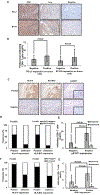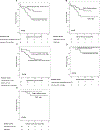Role of Tumor-Associated Macrophages in the Clinical Course of Pancreatic Neuroendocrine Tumors (PanNETs)
- PMID: 30670493
- PMCID: PMC6582654
- DOI: 10.1158/1078-0432.CCR-18-1401
Role of Tumor-Associated Macrophages in the Clinical Course of Pancreatic Neuroendocrine Tumors (PanNETs)
Abstract
Purpose: This study evaluated the potential role of immune cells and molecules in the pathogenesis and clinical course of pancreatic neuroendocrine tumors (PanNET).
Experimental design: Surgically resected PanNETs (N = 104) were immunohistochemically analyzed for Ki67 index, mitotic rate, macrophage, CD4+ cells, and CD8+ T-cell infiltration, as well as HLA class I, PD-L1, and B7-H3 expression. Results were correlated with clinicopathologic characteristics as well as with disease-free (DFS) and disease-specific (DSS) survival.
Results: The median age of the 57 WHO grade 1 and 47 WHO grade 2 patients was 55 years. High intratumoral CD8+ T-cell infiltration correlated with prolonged DFS (P = 0.05), especially when the number of tumor-associated macrophages (TAM) was low. In contrast, high peritumoral CD4+ cell and TAM infiltration was associated with a worse DFS and DSS. PD-L1 and B7-H3 were expressed in 53% and 78% PanNETs, respectively. HLA class I expression was defective in about 70% PanNETs. HLA-A expression correlated with favorable DSS in PD-L1-negative tumors (P = 0.02). TAM infiltration (P = 0.02), WHO grade (P = 0.04), T stage (P = 0.01), and lymph node positivity (P = 0.04) were independent predictors of DFS. TAM infiltration (P = 0.026) and T stage (P = 0.012) continued to be predictors of DFS in WHO grade 1 PanNET patients. TAM infiltration was the sole independent predictor of DSS for WHO grade 1 and 2 patients (P = 0.02). Therefore, this biomarker may contribute to identifying WHO grade 1 patients with poor prognosis.
Conclusions: TAM infiltration appears to be the most informative prognostic biomarker in PanNET. It may represent a useful immunotherapeutic target in patients with PanNET.
©2019 American Association for Cancer Research.
Conflict of interest statement
Figures




References
Publication types
MeSH terms
Substances
Grants and funding
LinkOut - more resources
Full Text Sources
Medical
Research Materials

